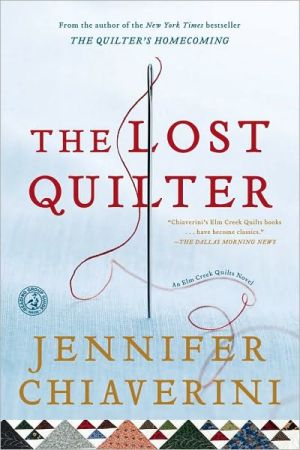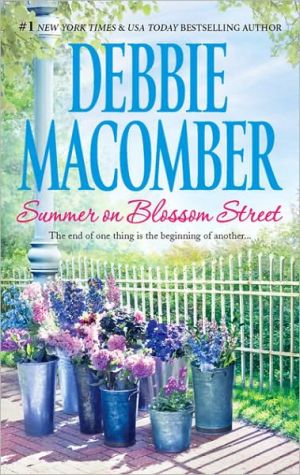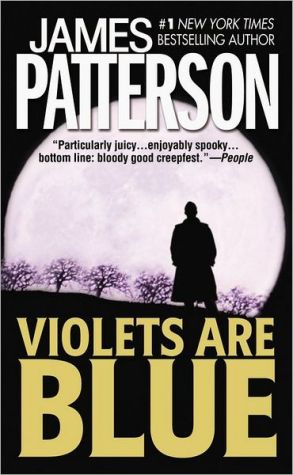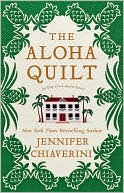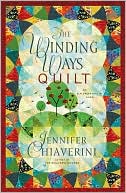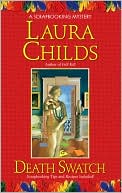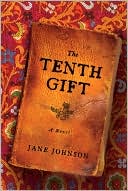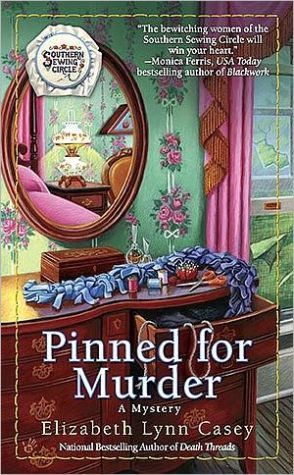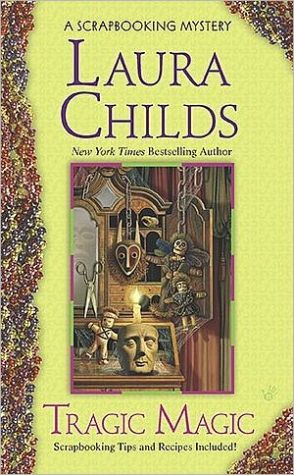The Lost Quilter (Elm Creek Quilts Series #14)
Master Quilter Sylvia Bergstrom Compson treasures an antique quilt called by three names — Birds in the Air, after its pattern; the Runaway Quilt, after the woman who sewed it; and the Elm Creek Quilt, after the place to which its maker longed to return. That quilter was Joanna, a fugitive slave who traveled by the Underground Railroad to reach safe haven in 1859 at Elm Creek Farm.\ Though Joanna's freedom proved short-lived — she was forcibly returned by slave catchers to Josiah Chester's...
Search in google:
Master Quilter Sylvia Bergstrom Compson treasures an antique quilt called by three names -- Birds in the Air, after its pattern; the Runaway Quilt, after the woman who sewed it; and the Elm Creek Quilt, after the place to which its maker longed to return. That quilter was Joanna, a fugitive slave who traveled by the Underground Railroad to reach safe haven in 1859 at Elm Creek Farm. Though Joanna's freedom proved short-lived -- she was forcibly returned by slave catchers to Josiah Chester's plantation in Virginia -- she left the Bergstrom family a most precious gift, her son. Hans and Anneke Bergstrom, along with maiden aunt Gerda, raised the boy as their own, and the secret of his identity died with their generation. Now it falls to Sylvia -- drawing upon Gerda's diary and Joanna's quilt -- to connect Joanna's past to present-day Elm Creek Manor. Just as Joanna could not have foreseen that, generations later, her quilt would become the subject of so much speculation and wonder, Sylvia and her friends never could have imagined the events Joanna witnessed in her lifetime. Punished for her escape by being sold off to her master's brother in Edisto Island, South Carolina, Joanna grieves over the loss of her son and resolves to run again, to reunite with him someday in the free North. Farther south than she has ever been, she nevertheless finds allies, friends, and even love in the slave quarter of Oak Grove, a cotton plantation where her skill with needle and thread soon becomes highly prized. Through hardship and deprivation, Joanna dreams of freedom and returning to Elm Creek Farm. Determined to remember each landmark on the route north, Joanna pieces a quilt of scraps left over from the household sewing, concealing clues within the meticulous stitches. Later, in service as a seamstress to the new bride of a Confederate officer, Joanna moves on to Charleston, where secrets she keeps will affect the fate of a nation, and her abilities and courage enable her to aid the country and the people she loves most. The knowledge that scraps can be pieced and sewn into simple lines -- beautiful both in and of themselves and also for what they represent and what they can accomplish -- carries Joanna through dark days. Sustaining herself and her family through ingenuity and art during the Civil War and into Reconstruction, Joanna leaves behind a remarkable artistic legacy that, at last, allows Sylvia to discover the fate of the long-lost quilter.Publishers WeeklyIn her 14th series installment, Chiaverini picks up the threads from The Runaway Quilt to spin another tale of adventure, love, perseverance and, of course, quilting. When Sylvia Bergstrom Compson and her staff find a stash of old letters hidden in an antique desk in the manor's attic, the story whips back to 1859 to recount the travails of the formidable Joanna North, an escaped slave who spent a brief respite at Elm Creek Farm. Joanna is recaptured and sent back to the Virginia plantation she thought she had finally escaped, and is eventually dispatched to Charleston to work under her former master's demanding newlywed niece, Miss Evangeline. As the Civil War looms, Joanna learns that for a slave, nothing-love, family, loyalty-is sacred or certain, and she never ceases plotting her final escape in the patterns of her scrap quilting. This satisfying and redemptive narrative unfolds with cinematic clarity, and Joanna's journey is sure to have readers holding their breath for her until the last page. (Apr.)Copyright © Reed Business Information, a division of Reed Elsevier Inc. All rights reserved.
Prologue\ On a clear, brisk October morning, Sylvia Bergstrom Compson descended the stone staircase from the veranda of Elm Creek Manor and set out for the barn, where the estate's caretaker awaited her. High above, an arrowhead of Canada geese crossed the cloudless sky and disappeared behind the gold and scarlet forest encircling the estate, their fading sentinel cries warning of winter's approach. A gust of wind carried the scent of wood smoke from a distant fire.\ Sylvia smiled and tucked her hands into the pockets of her navy wool cardigan, her sturdy shoes crunching dried leaves that had fallen upon the rear parking lot, empty except for the Elm Creek Quilts minivan and the red pickup belonging to Sarah and Matt McClure, two of the manor's few permanent residents. Curiosity had compelled Sylvia out of doors that morning, as the note Matt had left on the kitchen counter had not explained why he wanted her to meet him in the barn. It didn't matter. Sylvia was glad for any excuse to wander that way and enjoy the estate's glorious autumn beauty before winter took hold.\ She crossed the bridge over Elm Creek and followed the gravel road to the two-story red barn that her great-grandfather, Hans Bergstrom, had built into the side of the hill shortly after founding Elm Creek Farm in the late 1850s. Since then the barn had served as a shelter for farm animals, a garage, a plant nursery and toolshed, and more recently, as a woodshop for one of the manor's newest arrivals, Joe Hartley, the husband of Elm Creek Quilt Camp's newest teacher. A former steelworker forced onto disability decades earlier by a devastating injury at the mill, Joe had made quite a name for himself in the furniture restoration and carpentry business both in Ambridge, his hometown on the Ohio River, and throughout Pennsylvania. When his wife Gretchen's new job brought the couple to Elm Creek Manor, Sylvia had been pleased to offer Joe the empty half of her great-grandfather's barn for his flourishing business.\ In Sylvia's opinion, her generosity had already proven to be as rewarding for her as it was for Joe. Within days of his arrival, Joe had begun searching the manor's cluttered attic for long-forgotten antiques — chairs with broken spindles, bureaus with drawers that stuck — heirlooms that when they were no longer usable were moved into storage because they were too beloved to be discarded. Joe's careful ministrations had already restored her great-aunt Lydia's bureau and her grandmother's favorite rocking chair to perfect condition. Sylvia, who had found the task of clearing the attic of clutter too daunting, often thought that in hiring Gretchen as a teacher and offering her and her husband accommodations within the manor, Elm Creek Quilts had gained not one new staff member but two.\ As she approached the barn, Sylvia recognized voices within — Matt, the estate's caretaker; his wife, Sarah, Sylvia's dear young friend and cofounder of Elm Creek Quilts; and Joe himself, probably hard at work on another newly discovered heirloom from the attic. Entering through the large double doors, Sylvia discovered her friends in Joe's woodshop examining an antique desk that had evidently been well used by its original owner.\ "This is why you summoned me from my warm house on this chilly autumn morning?" Sylvia inquired. "I expected nothing less than a treasure chest stuffed full of the long-lost Bergstrom jewels."\ From kneeling to examine the bottom of the desk Matt sat up so quickly that he grazed his head on a drawer. "There are lost Bergstrom jewels?" he asked, rubbing his forehead and wincing.\ "She's kidding, honey," Sarah said, patting his shoulder, then placing a hand on her tummy and gazing heavenward as if praying that the twins she carried would have more astute senses of humor than their father.\ "To me, the desk itself is the treasure," said Joe. "This is solid cherry, quarter-hewn, and look at the detailing on the side panels. It's a bit scuffed and scratched, but I can take care of that, no problem."\ "Well, then, please go right ahead," said Sylvia, surprised. "You should know by now that you don't need to ask my permission. You haven't disappointed me yet and I doubt you ever will."\ "This desk needs more than a little sanding and stain," Joe warned, indicating a drawer on the right-hand side. "This drawer is locked, and the keyhole's so corroded from rust that the tumblers are fused solid."\ "So we probably couldn't unlock it even if we had the key." Sarah threw Sylvia an inquiring glance. "Which I assume we don't, unless it's dangling from a master key ring that I don't know about?"\ "I don't think so, and even if there were one, I wouldn't know where to look for it." Sylvia drew closer and peered at the rusty keyhole. It did indeed seem permanently fixed shut. "Well, it's still a lovely desk even without the use of one drawer. Those two on the left side should suffice. My suggestion is not to worry about it."\ "I'd think so, too, except — " Sarah beckoned to Matt. "Show her, honey."\ Matt nodded, rose, and lifted the side of the desk. Sylvia distinctly heard something slide over the wood and thump softly against the interior wall of the drawer. When Matt set the desk's legs back on the floor, the sound came again, whispery and dry, like old paper.\ "I can pry off the drawer front to get at whatever's inside," Joe said, "but not without damage. I checked the other drawers and they were made solid, with dovetail fittings. I can repair the drawer after, but it won't be as strong, and I can't promise that I won't scrape up the wood. And anything I do will lower its value as an antique."\ "But that's the only way to find out what's inside." Sarah had clearly already formed her own opinion of what should be done. "You weren't planning to have the desk appraised and sold anyway, were you, Sylvia?"\ "There might not be anything important in there," cautioned Matt. "I doubt it's a wad of hundred-dollar bills. You might ruin the desk only to find an old pocket dictionary or a pad of blank paper."\ "Or you might find an important piece of Bergstrom history," said Sarah, shooting her husband a pointed look. "Maybe another memoir, like the one your great-grandfather's sister Gerda wrote. Or maybe a bundle of letters. Or maybe the original deed to Elm Creek Farm! Wouldn't that be an amazing find? We could frame it and display it in the foyer."\ "My great-grandfather won Elm Creek Farm from a drunkard in a horse race," Sylvia reminded her. "Somehow I doubt he ever held anything as formal as a deed."\ But the desk's scratches and worn places suggested that it had seen a great deal of use. Someone — or perhaps generations of someones — had read and written letters at that desk, had kept ledgers or balanced accounts, had saved receipts and bills and children's report cards. Matt could be correct; the drawer might contain nothing of value. On the other hand, it could also shelter something that documented a part of the Bergstrom family history, a small clue that would illuminate a new facet of her ancestors' lives.\ The potential for discovery overruled any concerns she might have had about damaging the desk.\ "I don't think I could walk past this desk day after day without wondering for the rest of my life what that drawer contains," she declared. "Joe, please do your best to minimize the damage, but don't keep us in suspense too long."\ Joe retrieved tools from the pegboard above his workbench and set himself to the task. Within minutes he had pried off the drawer front, brushed off a thick layer of dust from the inside, and set the carved cherry panel on the desktop. Stooping over, he reached deep into the recess, tugged hard on something Sylvia couldn't see, and grimaced when the drawer didn't budge. He knelt down to get a better angle, filed off a thin sliver of wood from the right side of the drawer, and reached into the opening again. The old wood creaked and groaned in protest, but little by little, Joe forced it open until at last he yanked it free. "Stubborn piece of junk," he complained cheerfully. "The wood must've swelled with moisture. It was fused so tight, the lock was unnecessary."\ "One of my ancestors must have thought it was necessary once," Sylvia pointed out, coming closer to see what had been locked away for so many decades.\ There within the broken drawer lay a stack of yellowed envelopes, bound together with a frayed, faded ribbon.\ "Careful," Sarah murmured, though Sylvia did not need the warning to know to proceed cautiously. Gently she picked up the bundle, but when she tried to untie the ribbon, it crumbled to dusty fragments beneath her fingertips. Softly she blew the tattered bits aside and fumbled for her glasses, which hung from a silver chain around her neck.\ The envelope on the top of the stack was addressed to Miss Gerda Bergstrom, Elm Creek Farm, Creek's Crossing, Pennsylvania.\ "Creek's Crossing?" Joe asked, peering over Sylvia's shoulder.\ "Yes. Waterford was called that long ago." Sylvia set the stack of letters on the desktop and gently thumbed through them, counting ten in all, arranged with the earliest postmark on top. The second letter was also addressed to Gerda Bergstrom, but the other eight were addressed to the Bergstrom Residence. The fifth had been returned to the sender, who had evidently crossed out the words Creek's Crossing, written Waterford below it, and affixed a new stamp over the one that had been canceled. The remaining letters had been sent to Waterford. The return address on the first letter was from Virginia, while the others had been mailed from various towns in South Carolina, none of which sounded familiar.\ Sylvia carefully opened the top envelope, which was thankfully far less brittle than the ribbon had been. She withdrew a single sheet of yellowed paper, gingerly unfolded it, and began to read aloud:\ February 21, 1868\ Dear Miss Bergstrom,\ Please accept my sincere apologies for sending but a single letter in response to the great many you have sent to my family. It is unfortunate that your remarkable perseverance and prolifigacy as a letter-writer will have been in vain, for I regret that I do not have the answers you seek. I cannot dispute that my husband once kept a servant named Joanna in his service, but I have no idea what became of her after she left us. My husband customarily brought chastened, wayward servants back to our plantation at Greenfields in order to impress upon our other negroes the sad fate of the runaway, but these unfortunate few would remain with us only a short while after that. Since servants proven faithless were useless to him, my husband would be obliged to sell them, usually to our relations in Georgia or South Carolina. I confess that I do not recall whether the servant named Joanna faced these consequences; my husband kept so many negroes that I did not know them all, and I doubt I would have recognized the one in question in any case.\ I regret that I am unable to offer you more help in your search. It saddens me to chasten your enthusiasm, but every letter you may send us in the days to come, no matter how heartfelt or elegantly phrased, will meet with the same result. I have nothing to tell you about Joanna, nor shall I in the future. If I may say so, delicately, perhaps the time has come for you to abandon your fruitless quest before the perpetual disappointment takes its toll on your health.\ I remain most cordially yours,\ Mrs. Josiah Chester\ Formerly of Greenfields Plantation,\ Wentworth County, Virginia\ Sylvia's voice caught in her throat each time she read the familiar names: Joanna, a runaway slave who had found refuge at Elm Creek Farm. Josiah Chester, her cruel owner. Wentworth County, Virginia, the land Joanna had fled, and to which she had probably been returned upon her recapture.\ Sylvia's great-great-aunt Gerda Bergstrom had recorded the story of Joanna's daring escape and tragic recapture in her memoir. Gerda had also told of her own long, obsessive, ultimately unsuccessful search for Joanna after the war, and in the last pages of her memoir she had described a letter very much like the one Sylvia now held.\ The reason for the locked drawer was suddenly clear: Gerda had known secrets about the Bergstrom family she intended to conceal forever, even from her own descendants. Perhaps especially from them.\ "Mrs. Chester obviously didn't want to hear from Gerda again, but someone else was willing to write," Sarah prompted, indicating the other letters.\ Sylvia cleared her throat, returned Mrs. Chester's letter to the envelope, and picked up the second from the stack. "This one was mailed from South Carolina," she said, opening it. "Perhaps Gerda was able to track down some of the relatives that bought the Chesters' recaptured slaves."\ May 14, 1896\ Dear Miss Bergstrom,\ I am writing on behalf of my grandmother to inquire after the health of a gentleman, Mr. Douglass Frederick, whom she met when she enjoyed your kind hospitality at your farm in 1859. She would be very grateful for any information you could provide about him, especially his current address so that she may write to him directly.\ Yours sincerely,\ Mrs. Lenore Harris\ "Who's Douglass Frederick?" asked Matt. "Who's Lenore Harris, for that matter?"\ "I've never heard those names before," said Sylvia, shaking her head and returning the letter to the envelope.\ "Could she have meant Frederick Douglass?" asked Sarah. "Did he ever visit Elm Creek Farm?"\ The Bergstroms and their closest friends had been abolitionists who ran stations on the Underground Railroad, so it was not entirely out of the question. "I don't believe so," said Sylvia. "I'm sure Gerda would have recorded such an event in her memoir. As an abolitionist she considered Frederick Douglass one of her heroes, and she mentioned his autobiography."\ The third letter, written almost exactly a year later, was similar to the one before it:\ May 12, 1897\ Dear Miss Bergstrom,\ At my grandmother's request, I am writing to request any information you might have about Mr. Douglass Frederick, a gentlemen she met when traveling through the Elm Creek Valley in early 1859. For many years she has been interested in resuming their acquaintance, and she hopes that you may be able to assist her in this regard. My grandmother is aged and in failing health, so time is of the essence.\ Sincerely,\ Mrs. Lenore Harris\ Sylvia frowned, puzzled. "The first families of the Elm Creek Valley are well known. I don't recall the surname Frederick among them."\ "She's asking about a runaway slave, not a neighbor," said Sarah. "Think about it. 'Douglass Frederick' is obviously code for a slave who found freedom, and Lenore Harris's grandmother had reason to believe Gerda would know whom she sought. Who but a runaway slave would have been visiting Elm Creek Farm in early 1859?"\ "My great-grandparents and great-aunt were running a station on the Underground Railroad then," mused Sylvia. "Mrs. Harris's grandmother could have been trying to find a runaway who passed through here. That might explain why her letter is so vague. Perhaps she was a loved one left behind, trying desperately to discover what became of him, and yet still determined to protect his identity."\ "But why would she need to protect him in" — Matt glanced at the top of the page — "1897? Slavery had been abolished. Even if he had once been a slave, Douglass Frederick would have been a free man by then."\ "Yes, but as my great-great-aunt Gerda wrote, giving a people their freedom did not grant them their equality. They had a long, hard fight ahead of them." Sylvia thought for a moment. "It's possible that Lenore Harris didn't know why her grandmother was so curious, so insistent, and that's why the letters lack a certain directness."\ "Or her grandmother was deliberately vague," said Sarah. "According to Lenore, her grandmother met Mr. Frederick here, at Elm Creek Farm. It's obvious who she's looking for." Sarah looked around at the others, incredulous. "Oh, come on! Who else do we know who visited Elm Creek Farm in early 1859 and then wound up in South Carolina? Lenore Harris's grandmother must be Joanna!"\ "And 'Douglass Frederick' is an alias for the infant son she left behind?" Sylvia shook her head. "It's highly unlikely, my dear."\ "No, it's not," Sarah insisted. "All the pieces fit. The year. The location. The grandmother's presence at Elm Creek Farm and later in South Carolina. The absence of pertinent details. Notice that she doesn't ask about an African-American man, just in case he was passing as white. Joanna and her son were light-skinned, remember? They were going to use that to their advantage as they traveled from Pennsylvania to Canada. Lenore's grandmother had to be circumspect or she might give away their ruse."\ "I suppose it's possible," said Sylvia. "The letters arrived after Gerda's death. If Lenore's grandmother was indeed Joanna..."\ To think that the answers Gerda longed for had come too late.\ "If Gerda had already passed on, who locked the letters in the drawer?" asked Joe. "Someone knew they were worth saving."\ "I have no idea," said Sylvia. Another puzzle. Perhaps the remaining letters would provide more clues. She read each one carefully, only to find echoes of the same request for information about Douglass Frederick. There was nothing to suggest that anyone from Elm Creek Manor had ever responded, even to say that they knew nothing about the man Mrs. Harris's grandmother sought. Perhaps someone had responded, but the grandmother — Joanna? — had persisted despite the denials, knowing that the Bergstroms offered her last and best connection to her lost son.\ "Joanna Frederick," said Sarah. "Joanna Frederick from South Carolina. We have a name and a location now. We might be able to discover what became of her."\ Sylvia's pulse quickened, but experience had taught her not to entertain false hopes. "After all this time, dear? And with our best historical researcher away at graduate school?"\ "It won't hurt to dig around a bit more, even without Summer to guide us. We won't know if we don't try." Sarah's eyebrows arched. "You can't tell me you're not curious."\ Sylvia smiled back. "You wouldn't believe me if I did."\ After receiving Joe's assurances that he would do his best to repair the drawer and return the desk to its original beauty, Syl-via returned to the manor and climbed the grand oak staircase to the second-floor library. At her touch, double doors swung open into a room spanning the entire width of the south wing. Early morning sunlight spilled in through tall diamond-paned windows on the east wall, casting long rectangles of light on the rugs and hardwood floors. Oak bookcases filled the spaces between the windows on the east, west, and south walls, their shelves bowing slightly from the weight of leather-bound volumes and framed sepia-toned photographs of Sylvia's ancestors and the manor's earliest decades. She expected Joe would find more books and photos in the attic as he searched the accumulated possessions of four generations of Bergstroms for more furniture to restore.\ The remnants of the previous night's fire lay in the stone fireplace that dominated the south wall. To the left of the mantel hung the Castle Wall quilt her sister Claudia and sister-in-law Agnes had pieced as a memorial to Sylvia's first husband, James; to the right were nine display rods arranged three by three. From seven of the rods hung sections of the Winding Ways quilt Sylvia had made for her friends using fabrics that represented each woman's unique qualities. The mosaic of overlapping circles and intertwining curves, the careful balance of dark and light hues, the unexpected harmony of the disparate fabrics and colors created a wondrous design of many winding paths meeting, intersecting, parting, offering the illusion that the separate sections formed a single quilt. The illusion was broken by the missing sections in the lower right corner and the left middle side — Judy's portion and Summer's. When the two founding members returned to Elm Creek Manor, they would hang their nine-block sections in their proper places. Until then, the empty spaces served as a reminder that although they had left the beloved circle of quilters, they had not been forgotten.\ Sarah's dog-eared copy of What to Expect When You're Expecting lay open on one of the two armchairs drawn up to the hearth. Other chairs and sofas formed a square in the center of the room, awaiting the return of the remaining Elm Creek Quilters, who for the most part had scattered at the end of the season and would not return until March. Sylvia wondered what her friends would think of the bundle of letters discovered in the antique desk. She wished she had Summer's historical insight, Gwen's wisdom, and even Diane's sarcastic cynicism to guide her, to balance Sarah's headstrong enthusiasm. The Elm Creek Quilters' varied opinions rarely failed to help Sylvia gain clarity as she pondered a mystery.\ The mystery of the letters was far from the most uncertain or the most troubling of those her ancestors had left behind as their legacy. Foremost among the unanswered questions of her life were the truth of her heritage — which until a few years ago she had never had reason to doubt — and the fate of one runaway slave.\ Her first name was Joanna, and if she had any other, Sylvia did not know it. She knew nothing about Joanna except for the precious few details recorded in the handwritten memoir of her great-grandfather's sister, Gerda Bergstrom.\ In January of 1859, Joanna had sought refuge at Elm Creek Farm, a fugitive slave lost in the night, driven from her intended route north by a fierce snowstorm. Her destination was the neighboring farm, but when she spotted the signal quilt hanging on the Bergstroms' clothesline, she assumed she had reached a safe haven. Little did she know that Anneke Bergstrom had copied an abolitionist neighbor's pattern, unaware that the design carried a secret message to travelers along the Underground Railroad.\ Unexpectedly thrust into the clandestine world of runaways and stationmasters, the Bergstroms sheltered Joanna — injured, exhausted, and pregnant — throughout the winter. They concealed her from roving slave hunters, all too aware that their own lives and freedom hung precariously in jeopardy until Joanna gave birth and she and the baby were strong enough to continue north. Fearing for her family's safety, Anneke betrayed their secret, and Joanna was captured and thrown back into slavery. The slave hunters did not know about Joanna's son, whom she had been forced to leave behind in the Bergstroms' care.\ For a long time after Joanna's recapture, an anguished Gerda tried to find her. She wrote to Joanna's master, Josiah Chester, but he did not respond even before the Civil War disrupted mail service. Undaunted, she pursued other leads without any success. Gerda eventually abandoned the search, believing that Joanna must have died before she could make another escape attempt, before emancipation would have enabled her to travel freely. Surely if she had lived, she would have returned to Elm Creek Farm after the war to be reunited with her son — who, in his mother's absence, was raised as a Bergstrom.\ Joanna was light-skinned, and the father of her son was her white master, so the Bergstroms' unsuspecting neighbors had been easily fooled. Or perhaps willing to be fooled. Anneke Bergstrom, the woman Sylvia had always known as her great-grandmother, had given birth to her first child within weeks of Joanna. Anneke claimed the boys were twins and found a sympathetic doctor to create false birth certificates confirming the deception.\ For reasons of her own, Gerda had been unwilling to reveal within the pages of her memoir which of the "twin" boys was Anneke's and which was Joanna's, which of the boys was Sylvia's grandfather and which was her adopted great-uncle.\ In her heart of hearts, Sylvia knew that the question of her identity as a Bergstrom did not depend upon whether her grandfather was Anneke's child or Joanna's. An adopted child was as much a part of a family as a child born into it. She would always consider Hans and Anneke her great-grandparents, nothing would ever change that, and yet —\ It was difficult to contemplate that the woman who might have been her great-grandmother had been so cruelly separated from her child, that she had grieved, suffered, died — all without knowing the fate of her son. Even if Joanna was not her biological ancestor, Sylvia found it unbearable to imagine her last years.\ But not knowing what had become of her was even worse.\ Sylvia settled into the tall leather chair behind the broad oak desk that had belonged to her father, pulled out the second drawer, and withdrew a small bundle wrapped in soft ivory flannel. She hesitated before removing the protective cloth. So many times she had returned to Gerda's memoir hoping to discover an overlooked clue, but no matter how often she puzzled over cryptic phrases or asides that could be potent with meaning if only she understood the historical references, she never stumbled upon the answers she longed to find.\ Sylvia had found the journal in an old steamer trunk in the attic, wrapped in a Log Cabin quilt with alternating dark and light rectangles encircling a black center square. This was the quilt made famous in Bergstrom family lore, the quilt that had supposedly served as a signal assuring runaway slaves that they had found a station on the Underground Railroad. That detail turned out not to be true; Gerda had made the Log Cabin quilt in memory of Joanna during the long years of waiting and praying for her return. The other two quilts in the trunk, a scrappy strip quilt and a Birds in the Air crib quilt, had been the real signals; the first was Anneke's creation, the second, the work of Gerda and Joanna, made in haste after the first signal was compromised. A fourth quilt that had joined these three was now in protective storage in an unused room of the manor: another, larger Birds in the Air quilt, dilapidated, worn with time and hard use, made hundreds of miles away but unmistakably linked to the quilts made on Elm Creek Farm.\ Though it had belonged to her family for generations, a quilt camper named Margaret Alden had given the quilt to Sylvia after Gerda's journal helped them discover a possible connection to Sylvia's family estate. Known by the elder members of the family as both the "Elm Creek Quilt" and "the Runaway Quilt," its fragmented three layers were held together by quilting stitches depicting scenes from the Elm Creek Valley — the southern pass over the Appalachians, the original farmhouse that became the west wing of the manor, and several others, some Sylvia did not recognize. After Sylvia learned that Joanna's owner and Margaret Alden's great-grandfather were brothers, she concluded that Joanna herself had pieced the Runaway Quilt, concealing images of landmarks from her ill-fated journey so that one day she could return to Elm Creek Manor, to freedom and her son.\ But of course she had no proof, only sketchy details connected by thin threads of faith. Even this did not answer the questions that had tormented Gerda until the end of her life: What had become of Joanna, and why had she not returned to the Elm Creek Valley?\ Sylvia unwrapped the memoir and set the soft flannel aside. The slim volume's brown leather was worn and cracked with age, and though Sylvia opened the book carefully, the spine crackled from strain and sent up a whiff of old paper. Gerda's elegant script covered the unlined pages in fading ink, and here and there, she had written a chapter heading and date in larger letters. Gerda had begun her story in the spring of 1856, Sylvia noted as she turned the brittle pages, but Joanna had not entered the narrative until nearly two years later.\ A piece of paper fell from the book and tumbled to the desk.\ In a moment of panic, Sylvia thought Gerda's pages had come loose from the fragile binding. Just as suddenly, she realized that the thickness and color of this paper was different from that which Gerda had written upon, though it seemed no less delicate. Setting the memoir on top of the flannel, Sylvia took up the page by its corners and gingerly unfolded it, recognizing a handbill she had seen before, when she first read Gerda's story:\ $20 Reward!\ For the capture and return of a Negro woman, runaway or stolen from me two days after Christmas. She is of medium height and build; she may attempt to pass as White or Free but you will know her by the fresh mark of a flatiron, which I made on her right cheek. She is an expert with the needle and may have in her possession a silver thimble and needle case, which belonged to my late Mother and which the Negress has stolen. The above reward of twenty dollars will be given upon return of the said Negress to me or my agents, and an additional ten dollars will be provided for the restoration of my stolen goods. Josiah Chester, Wentworth County, Virginia, December 29, 1858.\ \ Twenty dollars for a person, ten for a needle case. Fighting her disgust, Sylvia scanned the handbill for pertinent details. Josiah Chester had wasted little time in seeing that his handbills were distributed as far north as central Pennsylvania; he obviously considered Joanna a valuable slave even if he had been unaware that she was carrying his child. Oddly, though, he never mentioned her name, or even her age, and to say that she was medium height and build was vague enough to be entirely unhelpful. He must have counted upon the scar to identify her — the scar he had made and spoke about almost indifferently, as if cruelly burning a woman's face did not burden his conscience. Josiah Chester's words said more about him than they did about the woman they were intended to describe.\ Sylvia herself might be descended from that hateful man. Perhaps that was why she had not begun her own search for Joanna sooner.\ For she knew she must pick up the thread of Gerda's thwarted search or, like her great-great aunt, she would be haunted by unanswered questions until the end of her days — Joanna's fate, her heritage, the astonishing letters discovered in the locked desk drawer.\ The handbill provided a sketchy description, a date, and a possible location. The slave catchers who had taken Joanna from Elm Creek Farm had almost certainly returned her to the Chester plantation in Wentworth County, Virginia. Based upon Margaret Alden's story of the Runaway Quilt, Josiah Chester later sold Joanna to his brother, Margaret's great-grandfather. After that, Joanna's trail disappeared into history. She had been lost to Gerda and to her son forever.\ Unless Sarah was correct — and Mrs. Lenore Harris's grandmother was the lost quilter Gerda had searched for but had never found.\ Sylvia resolved to call her favorite historical researcher, Summer Sullivan, a founding Elm Creek Quilter and newly enrolled graduate student at the University of Chicago. If Sylvia were to have any hope of picking up the thread of Joanna's life, she must know the location of the Chesters' plantation. If anyone could track down that information using only the scant details in the old letters, Summer could. Sylvia would enlist the help of her favorite quilt historian too, longtime friend Grace Daniels, a curator at the De Young Museum in San Francisco. Together those two clever, resourceful women might help her discover what had become of Joanna's former masters. And if the Chester family's personal papers had survived the Civil War, perhaps they mentioned a certain slave woman, an incorrigible runaway worth keeping only because of her incomparable skill with a needle. Perhaps some diary or ledger or letter had recorded her fate.\ Perhaps Sylvia and her friends would find the answers Gerda had been unable to discover.\ Copyright© 2009 by Jennifer Chiaverin
\ Publishers WeeklyIn her 14th series installment, Chiaverini picks up the threads from The Runaway Quilt to spin another tale of adventure, love, perseverance and, of course, quilting. When Sylvia Bergstrom Compson and her staff find a stash of old letters hidden in an antique desk in the manor's attic, the story whips back to 1859 to recount the travails of the formidable Joanna North, an escaped slave who spent a brief respite at Elm Creek Farm. Joanna is recaptured and sent back to the Virginia plantation she thought she had finally escaped, and is eventually dispatched to Charleston to work under her former master's demanding newlywed niece, Miss Evangeline. As the Civil War looms, Joanna learns that for a slave, nothing-love, family, loyalty-is sacred or certain, and she never ceases plotting her final escape in the patterns of her scrap quilting. This satisfying and redemptive narrative unfolds with cinematic clarity, and Joanna's journey is sure to have readers holding their breath for her until the last page. (Apr.)\ Copyright © Reed Business Information, a division of Reed Elsevier Inc. All rights reserved.\ \
